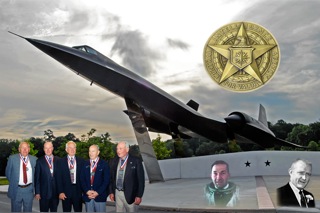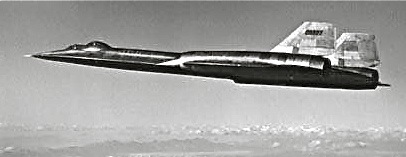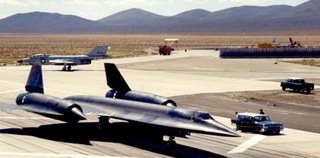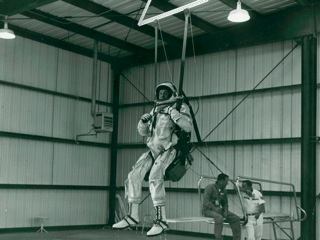


 |
 |
 |

 All of the pilots selected to fly the A-12 were active duty Air Force fighter pilots prior to being transferred out of the Air Force to become civilian employees of the CIA. This transfer stipulated that the Air Force pilots were required to resign their officer commissions for the duration of their CIA involvement. This was done with the understanding that they would be reinstated into the Air Force at the end of their contract with the CIA. Their compensation and insurance programs were similar to that afforded the CIA U-2 pilots. Of the eleven pilots selected, six were still on contract with the CIA when the Reconnaissance missions of Operation BlackShield started. The training program was not a rigid curriculum, but was based on typical fighter Squadron transition steps. Of course there were no A-12 experienced instructors at the beginning of the training program in 1962. One Lockheed Test Pilot formed the core of experience to use as an instructor in the beginning. Particularly, Louis Schalk, the first man to fly the A-12, was the designated "leader of the pack". He was the Chief Lockheed Test Pilot on the A-12 Program, also serving as the first Instructor Pilot of the Blackbird era. A Flight Simulator was not developed for the A-12 program. A Flight Simulator would probably cost more than a production A-12.
All of the pilots selected to fly the A-12 were active duty Air Force fighter pilots prior to being transferred out of the Air Force to become civilian employees of the CIA. This transfer stipulated that the Air Force pilots were required to resign their officer commissions for the duration of their CIA involvement. This was done with the understanding that they would be reinstated into the Air Force at the end of their contract with the CIA. Their compensation and insurance programs were similar to that afforded the CIA U-2 pilots. Of the eleven pilots selected, six were still on contract with the CIA when the Reconnaissance missions of Operation BlackShield started. The training program was not a rigid curriculum, but was based on typical fighter Squadron transition steps. Of course there were no A-12 experienced instructors at the beginning of the training program in 1962. One Lockheed Test Pilot formed the core of experience to use as an instructor in the beginning. Particularly, Louis Schalk, the first man to fly the A-12, was the designated "leader of the pack". He was the Chief Lockheed Test Pilot on the A-12 Program, also serving as the first Instructor Pilot of the Blackbird era. A Flight Simulator was not developed for the A-12 program. A Flight Simulator would probably cost more than a production A-12.
Early planning did establish a need for a dual control version of the A-12. The fourth A-12 built was a two-seat version with an elevated rear cockpit with almost full duplicate controls. The rear cockpit was used for first flight familiarization for new pilots and as an supervisory location for the Instructor pilot on later training missions. The trainer version of the A-12, like the first built A-12's were equipped with the J-75 afterburning engine. The intended J-58 engine was not ready for flight when the airframes were ready. The trainer was never upgraded to J-58's. The trainer was the only airplane in the world to be equipped with a pair of J-75's.
 Before any flight training commenced, the airplane engineering ground school must be done to acquaint the trainee with the airplane mechanical systems.
Before any flight training commenced, the airplane engineering ground school must be done to acquaint the trainee with the airplane mechanical systems.
Note: the last pilot trained was not selected by the normal system. He was one of the on-site F-101 chase pilots, with additional duties as F-101 instructor pilot and test pilot. Pilot attrition led to a need to train replacements. His selection and training was done a few years after the first group started, hence all of the early group were his instructor cadre. Lots of experience in this group was impressed on the "New Guy" This "New Guy" is the author of this treatise on training, Frank Murray.
The usual "Ground School" training for the A-12 pilot trainees was mainly performed by the engineers that were on hand at Area 51 to support the Lockheed development/test program. At the same time this training was on-going, the Flight Manual was being developed by a small group of Lockheed engineers and a few of the Air Force pilots that were assigned to perform the Standardization/Training function at the Area.
The usual systems operation training was done every day in the early days of the Program. In the early days of the Program, it was not unusual to see "Kelly" Johnson attend the training sessions. "Kelly" of course is the Godfather of the A-12 design. The basic systems of the A-12 were not really new ideas for the pilot trainees, but, some new systems like the Cameras, Defensive Systems (Jammers), Inertial Navigation System (INS), system recorders, and the on-board telemetry system (Birdwatcher) were new items to all of the A-12 pilot trainees. The ground training was on-going after the pilots started flying the airplane.
Before flight training can commence, the pilot must be fitted and trained to use the Pressure Suit. (See a previous treatise "Suit Up" on the Roadrunners website)
The basic flight training program comprised a ten mission transition to the A-12. The experience requirements imposed on the A-12 pilot trainees, made learning to fly the A-12 an academic situation. The A-12 is not a difficult airplane to fly, but it has performance in speed and altitude that is new to even the most experienced fighter pilots.
The A-12 Trainer was always used to acquaint the trainee with the flight characteristics, handling qualities, navigation system, air refueling and of course take-off and landing.
The flight training regimen follows.
This mission is a Familiarization flight with the student pilot in the back seat of the A-12 Trainer.
The flight demonstrates normal take-off, climb, cruise, navigation, air refueling, flight characteristics with and without Stability Augmentation System (SAS), slow flight, single engine flight characteristics, and normal traffic pattern and touch and go landings followed by a full stop landing with the 40' drag chute.
This mission is much the same as #1 except that the student pilot is flying from  the front seat and he does most of the flying with the Instructor monitoring for safety. Several touch and go landings are made as well as simulated single engine approaches and single engine go-arounds. These followed by a full stop landing using the drag chute.
the front seat and he does most of the flying with the Instructor monitoring for safety. Several touch and go landings are made as well as simulated single engine approaches and single engine go-arounds. These followed by a full stop landing using the drag chute.
This mission has the student pilot again in the front seat, this time flying in his pressure suit. This takes some getting used to due to the limited vision problem caused by the helmet visor and the general limits of mobility imposed by the pressure suit. The flight concentrates on the use of the INS, air refueling and general mission handling while in the pressure suit. The Instructor pilot is in the back seat for safety and evaluation.
This mission is the first SOLO flight in the A-12 trainer. The back seat is buttoned up and the canopy is locked. The Instructor pilot monitors the flight from the chase F-101 or the Mobile Tower at the end of the runway. The mission includes preprogrammed INS flight paths with at least two air refuelings. After let down to the home airport, several touch and go landings are made followed by a simulated single engine full stop landing,
This mission is designed to prepare the student pilot with some of the flight parameters of the single seat A-12 equipped with the J-58 engines. The acceleration maneuver used to efficiently get the A-12 on to high Mach is a key step of training. The A-12 trainer does not have the powerful J-58 engines, but it can be used to demonstrate the flight regime necessary to accelerate the J-58 powered single seat A-12. The Instructor pilot usually flies in the back seat on this mission.
This mission is a night time training exercise with the student pilot in the pressure suit and the Instructor pilot usually flying in his summer suit (non-pressure). This flight includes INS exercises with air refuelings and practice instrument approaches, and touch and go landings, simulated single engine approaches and a full stop with drag chute landing.
This mission is the first flight for the student pilot in the single seat J-58 powered A-12. Before making this flight the student was required to observe several starts and launches of this model A-12. The Instructor pilot acts as chase pilot on this mission, flying from the F-101 chase plane from take-off to the landing of this A-12.  Of course this is the big transition for the student pilot. A step by step approach is used to get the pilot to the point where he can handle the challenges of this more powerful airplane. On this mission an INS route is flown within the Special Operating Area (SOA) accelerating to approximately Mach 2. This followed by descent to air refueling. After refueling completion the pilot accelerates the airplane again on a track that will exit the SOA above Mach 2, usually leveling off at this speed and flying the INS route, arriving back at the home base after letdown. Normal landing follows with the Instructor pilot observing from the chase position. The A-12 was equipped with canopy mounted over-the-shoulder cameras to provide a record of the cockpit instruments and pilot actions during this mission. The Instructor pilot and student pilot review the footage for clues to pilot actions during critical phases of this flight.
Of course this is the big transition for the student pilot. A step by step approach is used to get the pilot to the point where he can handle the challenges of this more powerful airplane. On this mission an INS route is flown within the Special Operating Area (SOA) accelerating to approximately Mach 2. This followed by descent to air refueling. After refueling completion the pilot accelerates the airplane again on a track that will exit the SOA above Mach 2, usually leveling off at this speed and flying the INS route, arriving back at the home base after letdown. Normal landing follows with the Instructor pilot observing from the chase position. The A-12 was equipped with canopy mounted over-the-shoulder cameras to provide a record of the cockpit instruments and pilot actions during this mission. The Instructor pilot and student pilot review the footage for clues to pilot actions during critical phases of this flight.
This mission is much like #7 except that the acceleration/cruise out is allowed to increase to approximately Mach 2.6. The Instructor pilot flies in the chase and provides mission review using the over-the-shoulder camera imagery.
This mission is like #7 except that the speed/altitude schedule is flown to Mach 3.0.
The Instructor pilot performs as in #8.
This is the "Graduation Mission". Usually includes flying a "hot" leg at Mach 3 + with a refueling following, then another acceleration to speed/altitude followed by a recovery to home base. This completes the normal training regimen. Follow-on training in sensor operation, nighttime operation, ECM training is part of the concurrent operation at the home base.
After the basic check-out training phase, the new pilot is scheduled to fly local sorties with the rest of the assigned A-12 pilots. These missions varied from simple one topoff refueling followed by a climbout/cruise at high mach/altitude along one of many routes pre-planned around the Western US. Theses sorties allowed the new pilot to experience the full envelope of the A-12 airplane, climbing to near maximum altitude, turns at maximum altitude/minimum equivalent airspeed. It was that flying in these conditions that the pilot occasionally experienced duct unstarts and the attendant difficulties of flight management.
Up to this point in his training the new pilot had not operated the Sensor systems the A-12 is equipped with. Of course the reason for having the A-12 is to provide carriage of the high resolution cameras over denied territories in adversary countries. The normal operation of the A-12 airplane is relatively simple, fly the airplane to designated places, turn on the camera on cue, then turn it to standby at the end of the photo pass. Sounds simple, but couple this action with responses from the adversary like firing SAM's at you!! This will get your attention. The A-12 was equipped with one high resolution camera designed to take high quality pictures of the target from overhead. Some peripheral coverage is a part of this design but the main reason for being there is to not blink as you pass overhead. The camera systems were exercised on training missions flown over areas of resolution targets, usually painted on rooftops of bases. This exercise is important from a pilot training aspect, but is necessary for quality assurance and training of the camera company personnel. Several camera systems were exercised, each with unique control panel features. The pilot was well briefed on the operation of each system. Camera system operation was routinely a part of pilot proficiency training.
This phase of training was designed to make the pilot aware and responsive to the needs to defend the A-12 while operating over denied territory. The various parts of the ECM suite (Defensive Systems) work in concert to defeat attacks by Surface to Air Missile (SAM) systems. The pilot was trained to use the few indicators that were installed for him to view. The names of the subsystems were cryptic, only explained as to what they were intended to do. A full up training/exercise mission would have the pilot overfly the target area for a photo pass, coupled with an activation of the simulated SAM systems. This action gave the new pilot the opportunity to see what the onboard ECM systems do during an attack. Sadly, not much of this training happened so the pilots had to wait until BlackShield to see the systems work for "REAL".
The ECM system displays and controls were sparse, probably due to the CIA reluctance to let the pilot know how the system worked, for security reasons. It did make things simple.
This phase of training and continuing operations was probably the best thing done to help the development/testing/training programs.
Before each mission was flown, the operation staff/training cadre/and the contractor tech reps were present. In the first days of pilot training, the Instructor pilot would describe the mission to be flown. The chase pilot was present at this briefing. A staff officer would lead the briefing, making high notes of the flight area to be used, the refueling area/tanker
Locations. The weather conditions for the flight area were described as well as the terminal area. Any contractor special conditions were discussed. In the early days of pilot training, the sensor company tech reps provided valuable insights into operation of their equipment, they were the only source of system knowledge in the early days of OXCART.
Post flight training debriefings were an important followup. Many of the A-12 system sub-contractors attended the flight debrief to gain first hand reports of their system performance. The debriefing was usually conducted as soon as the pilot had his pressure suit removed.
Several other areas of training were conducted to help prepare the new A-12 pilot cope with his mission. Some basic survival training was deemed
 necessary, such as coping with landing in water while wearing the pressure suit, parachute landing, survival off-the-land, jungle survival, seacoast etc. Some of these training events were fun times, good stuff to know. Other things needed to learn, such as resistance to interrogation, were not so nice to experience but necessary elements.
necessary, such as coping with landing in water while wearing the pressure suit, parachute landing, survival off-the-land, jungle survival, seacoast etc. Some of these training events were fun times, good stuff to know. Other things needed to learn, such as resistance to interrogation, were not so nice to experience but necessary elements.
Water survival training photos by Oxcart Helo pilot - Charlie Trapp
The author has the greatest admiration of the people the Agency provided to conduct the Corollary training. They gave of themselves, never really having a good day either.
Since this writing was intended to describe the flight training element, all corollary training description was intentionally sparse.
 |
 |
 |